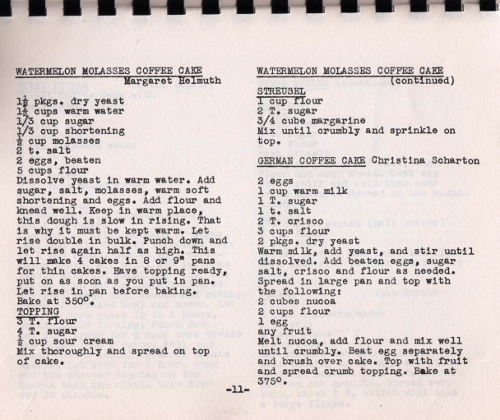What the Heck Is Watermelon Molasses?
After reading about it in an old cookook, there was only one way to find out how it tasted
Food FeaturesI spent half a day boiling down watermelons, all because of a book I bought at the Goodwill years ago. It was an unassuming 1979 spiral-bound cookbook from Fresno, full of casserole and Jell-O salad recipes. But once I browed deeper through its yellowed, typewritten pages, I noticed something puzzling about Our Favorite Recipes. Besides otherwise standard 1970s fare, the book had recipes with East European-sounding names like vareniks, glase, and berrocks. Most intriguing of all, a number of recipes called for something called watermelon molasses.
It’s an unlikely ingredient with an unlikely background. When the Internet and all of the Russian and German cookbooks as I could get my hands on failed me, I decided the best way to learn why a bunch of ladies in California’s Central Valley once reduced vats of watermelon juice was to do the same thing myself.
Thus, one hot summer day, my clothes spattered with rosy blotches and my sink full of sticky strainers and stockpots, I followed the cryptic procedure outlined in Our Favorite Recipes and haplessly transformed four watermelons into a quart of grainy, garnet-red syrup with a musky aroma reminiscent of freshly picked summer squash. While sweet, it wasn’t very fruity—hardly the rediscovered delight I’d imagined pouring over pancakes or mixing into cocktails. Who would go through so much work to make something so esoteric?

Resourceful, frugal people, that’s who. As it turns out, the Volga Germans who came to Fresno in the late 1800s were ancestors of some of Our Favorite Recipes’ contributors. And Volga Germans had an unrivaled fondness for watermelon.
Between 1763 and 1767, Germans of a number of faiths, including Lutherans and Mennonites, took up Catherine the Great’s invitation to Europeans to immigrate to Russia. They farmed along the Volga River and collectively came to be called Volga Germans. During their years in South Russia, they maintained their language and culture and didn’t pick up many of the local ways, but they did acquire the region’s mighty affection for growing watermelon and enjoying big slabs of the fruit at social gatherings. Watermelon molasses—nardek in Russian—allowed them to preserve any melons they couldn’t enjoy fresh or pickle.
About a century later, many Volga Germans emigrated from Russia to America and parts of Canada. They were very good dry land farmers, and some of these immigrants settled in Fresno County, in California’s Central Valley. Through intermarriage with other families, their Mennonite faith melded with other churches and their Russian-influenced food heritage underwent the same great American evolution, which Our Favorite Recipes entries like “Yankee Doodle Goulash” so perfectly illustrate.
But use of watermelon molasses wasn’t just a fluke of the Central Valley—it was a thing in the Plains States, too. In her cookbook Prairie Home Cooking, Judith M. Fertig even offers a recipe for watermelon syrup. “In Russian Mennonite communities that dot the prairie from central Kansas up through the Dakotas to Saskatchewan and Manitoba, the love of watermelons is legendary. Farmers and gardeners grow the small, thin-skinned varieties that will keep well, wrapped in newspaper in a cool cellar, until they are served for the last time at Christmas,” she writes. “They also make this syrup of these sweet melons to use (in place of sugar) in making pfeffernuesse, or to drizzle on pancakes or coffeecakes.”

I did use my watermelon molasses in a few of Our Favorite Recipes’ coffee cakes, but discovered that I liked its subtle vegetal character best when drizzled into braised greens: I soften half a chopped onion in olive oil, then add about two bunches of tough, bitter-ish greens (kale and collards are my favorite). Once those have wilted, I add a few tablespoons of water and about a tablespoon of apple cider vinegar. After maybe 20 minutes of gentle braising with the lid off, I stir in a tablespoon of watermelon molasses and season the whole works with salt and pepper.
It’s a far cry from those traditional coffee cakes and sweet dumplings, but I like the watermelon molasses best when deployed as a stealth ingredient and not a flavor star, in dishes where its savory edge and unusual complexity add depth rather than confusing the palate. Besides the greens, I love it added to sauces and dressings—I’ll sneak it into a batch of homemade ranch, or a barbecue sauce that I don’t want to be too cloying.
Should you want to make your own watermelon molasses, first get watermelons. One big one that’s dense with liquid will do the trick for curious nardek day trippers. From one nearly nine-pound watermelon, I got 12 cups of juice, which I strained to remove any stray solids. Then I cooked it down…and down…and down…and got about a cup of watermelon molasses. It took maybe three hours to reduce (the advantage of making a smaller batch). If you make a larger batch, it is possible to can watermelon molasses; in fact, I still have a jar I processed in 2013. The thought of cracking it open makes me wary. It took so much work to make the stuff, and I don’t want to use it lightly.
Even so, I am still considering making a new batch this summer—I refuse to let go of the hope that this time, it might blow my mind. I may not adore nardek itself, but I value the time-travel experience of making it in my own kitchen, which introduced me to Volga Germans and reminded me how precious sweetness is, wherever it comes from.

Smashed watermelon photo by KT King CC BY
Sara Bir is Paste’s food editor.